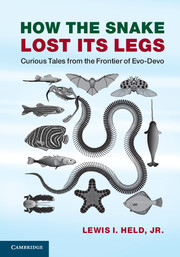3 - The butterfly
Published online by Cambridge University Press: 05 June 2014
Summary
How the butterfly got its scales
Butterflies and moths are lepidopterans. The name means scaly wings. Under a microscope their wings resemble shingled roofs [335,1636]. What seem to be solid areas of color to our naked eyes are actually tiled mosaics of overlapping scales [88], each of which has a uniform color [1087,1513,1630]. There are on the order of a million scales per wing, approaching the megapixel capacity of a cheap digital camera.
Why scales? We don’t know their original function [880,1901], but they certainly come in handy when their bearer is caught in a spider web. Scales detach easily from their sockets, so the struggling captive can often wriggle free, leaving its scales behind on the web like a dusty fingerprint, or “wingprint” as it were [602].
Butterfly scales are homologous to fly bristles [722,2510], and bristles pre-date scales [880], so our evo-devo quest for the origin of scales leads to a question of how a conical bristle became a flat scale. Bristles are erected on a scaffold of microfilaments and microtubules [197,888], but we know too little about the trestlework of scale anatomy to guess how the cytoskeleton was reshaped during the transitional period [774]. Even so, we can glean a few clues about scale origins from what is known about the cellular and genetic basis of scale development.
Scales and bristles are both variations on a theme that pervades all insect sensilla [1230]. Those sensilla (miniature sense organs) are assembled from small cohorts of cells that descend from a single cell – the sensory organ precursor (SOP). Regardless of whether the sensillum detects touch, smell, or taste, its SOP undergoes a fixed number of cell divisions, each of which has a fixed orientation [1470,1654]. Stereotyped mitoses are common in embryonic cleavage but unusual thereafter [490]. The SOP subroutine constitutes a small-scale module in the arthropod genome.
- Type
- Chapter
- Information
- How the Snake Lost its LegsCurious Tales from the Frontier of Evo-Devo, pp. 43 - 74Publisher: Cambridge University PressPrint publication year: 2014



